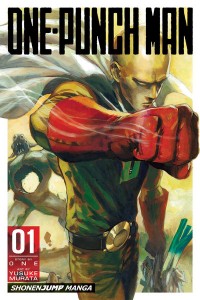By ONE and Yusuke Murata. Released in Japan by Shueisha, serialization ongoing online at Tonari no Young Jump. Released in North America by Viz.
It’s always very tricky to do a satire of something in Japanese manga, but I’ll give credit to Shueisha, they’re not afraid to let people try. Gintama’s popularity speaks for itself, and Medaka Box’s deconstruction of nearly everything ran far longer than folks expected. Now we have One-Punch Man, based on ONE’s webcomic of the same name. This time it’s superhero tropes, both Western style and Japanese, that are under the microscope. I am amused that this series, which has been running digitally for Viz for some time, is coming out in print right as My Hero Academia, a straighter take on the same sort of genre, is being released in Weekly Jump itself. ONE is not the greatest artist in the world – though you could argue that’s exactly what makes his webcomic work so well – and so they brought in Eyeshield 21’s Murata to do the art. The result is strong, mostly due to the dissonance between that ultra-serious art and ONE’s bald blob of a hero.
The cover is a bit of a joke in and of itself, showing our hero in a dramatic pose and looking exactly like the Dragonball-esque hero he’s meant to be making fun of. Luckily, once we start the manga proper, Saitama is rendered mostly as ONE did in the original webcomic, as a simply-drawn man who looks almost like a stick figure compared to those around him. The flashbacks we see of him as a wannabe salaryman with hair just aren’t as effective – he looks far too normal, like one of Eyeshield’s high school football guys. He also has a personality to go with his art style, as his flat, deadpan delivery of many lines stems from training himself to be the overpowered nightmare that he is now, unable to find a decent fight as he beats everyone – you guessed it – in one punch.
Saitama is also rooted heavily in the real world – hence his despair at missing bargain day at the supermarket. The rest of the cast we see are far more traditional, the better to contrast with our hero. Genos, a cyborg with a tragic past, is pure straight man, and the best joke he has involves his long, text-heavy backstory almost crushing Saitama with the sheer weight of boring words we’ll never remember. In the second volume, we see Sonic, a hero who uses speed to overwhelm his opponents, is a pretty bishonen, and has a bloodthirsty desire for a good fight – again, all played out very straight. So of course Saitama wins by accidentally punching him in the balls. We end by seeing that Saitama, who is a superhero for fun, doesn’t even realize that you need to be registered in order for anyone to know who the hell you are.
Without Saitama, this series is another standard superheroes and punching title. *With* Saitama, you get the humor that makes One-Punch Man a cut above. I look forward to seeing the authors ride that dissonance in future volumes.

